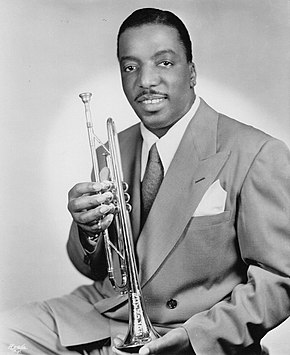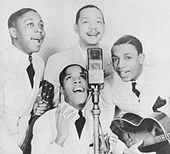
In 1943, Billboard magazine published a chart ranking the "most popular records in Harlem" under the title of the Harlem Hit Parade. Placings were based on a survey of record stores primarily in the Harlem district of New York City, an area noted for its African American population which has been called the "black capital of America". The chart is considered to be the start of the lineage of the magazine's multimetric R&B chart, which since 2005 has been published under the title Hot R&B/Hip Hop Songs.
Most of 1943's number ones were in the jazz and swing genres, which were among the most popular styles of music in the early 1940s. The year's longest-running chart-topper was "Don't Cry Baby" by Erskine Hawkins and his Orchestra, which spent a total of 14 non-consecutive weeks atop the chart between August and December. Two acts each achieved the feat of topping the chart with three different songs. Lucky Millinder and his Orchestra topped the listing with "When the Lights Go On Again", "Apollo Jump" and "Sweet Slumber", which was the final number one of 1943. Duke Ellington and his Famous Orchestra reached the top spot with "Don't Get Around Much Anymore", "A Slip of the Lip (Can Sink a Ship)" and "Sentimental Lady". The latter two songs were the two sides of the same record, but Billboard listed each in the number-one position for one week. Ellington's recording of "Don't Get Around Much Anymore" was one of two versions of the song to top the chart during 1943; the Ink Spots also reached number one with a vocal version of the track. Ellington had originally composed and recorded the track in 1940 as an instrumental with the title "Never No Lament", but it was re-titled and re-released after other artists recorded a vocal version with lyrics written by Bob Russell.
Louis Jordan and his Tympany Five topped the chart for the first time in 1943 with "What's the Use of Getting Sober (When You Gonna Get Drunk Again)"; Jordan would go on to be by far the most successful artist of the 1940s on Billboard's R&B charts. His tally of 18 chart-toppers was a record which would stand until the 1980s, and he spent 113 weeks at number one, a record which would still stand in the 21st century. His jump blues style was also a major influence on the later development of rock and roll. The King Cole Trio had two number ones in 1943, the first chart success for pianist and vocalist Nat King Cole, who would move on from the jazz field to become a hugely successful pop artist. Three of 1943's number ones had sufficient crossover appeal to also top Billboard's overall National Best Selling Retail Records chart, the forerunner of the modern Hot 100. The first was the year's first chart-topper, "White Christmas" by Bing Crosby with the Ken Darby Singers and John Scott Trotter and his Orchestra, which has remained a perennial favourite for more than 70 years and has been acclaimed by Guinness World Records as the world's best-selling single, with estimated sales in excess of 50 million copies worldwide. Later in the year, "I've Heard That Song Before" by Harry James and his Orchestra and "You'll Never Know" by Dick Haymes and the Song Spinners topped both listings. "You'll Never Know" was among a number of records released with a choral backing because the 1942–1944 musicians' strike prevented union musicians from making commercial recordings.
Chart history




Notes
a. Jordan's first 16 number ones occurred at a time when Billboard published only one R&B chart. His final two number ones occurred during a period when the magazine published two charts and each topped both listings, but the figure of 113 weeks at number one does not double-count weeks when he topped both.
References
- Goldfarb, Michael (February 1, 2011). "Who 'owns' Harlem, the capital of black America?". BBC. Archived from the original on May 17, 2021. Retrieved September 5, 2020.
- Whitburn, Joel (1996). Joel Whitburn's Top R & B Singles, 1942–1995. Record Research Incorporated. p. xii. ISBN 978-0-89820-115-4.
- "Swing Music Genre Overview". AllMusic. Archived from the original on October 12, 2020. Retrieved September 4, 2020.
- ^ Whitburn, Joel (1988). Joel Whitburn's Top R & B Singles, 1942–1988. Record Research Incorporated. p. 137. ISBN 978-0-89820-068-3.
- Furia, Philip; Lasser, Michael L. (2006). America's Songs: The Stories Behind the Songs of Broadway, Hollywood, and Tin Pan Alley. Taylor & Francis. p. 174. ISBN 978-0-415-97246-8.
- Whitburn, Joel (2004). Top R&B/Hip-Hop Singles: 1942–2004. Record Research Incorporated. p. 309. ISBN 978-0-89820-160-4.
- Whitburn, Joel (2004). Top R&B/Hip-Hop Singles: 1942–2004. Record Research Incorporated. p. 783. ISBN 978-0-89820-160-4.
- Dahl, Bill. "Louis Jordan Biography & History". AllMusic. Archived from the original on December 12, 2021. Retrieved December 11, 2021.
- Ruhlmann, William. "Nat King Cole Biography & History". AllMusic. Archived from the original on March 31, 2019. Retrieved September 10, 2020.
- "Best-selling single". Guinness World Records. Archived from the original on April 11, 2022. Retrieved September 5, 2020.
- "The Billboard Music Popularity Chart". Billboard. December 26, 1942. p. 24. Retrieved September 5, 2020.
- ^ "The Billboard Music Popularity Chart". Billboard. March 6, 1943. p. 24. Retrieved September 11, 2020.
- ^ "The Billboard Music Popularity Chart". Billboard. July 24, 1943. p. 16. Retrieved September 11, 2020.
- Jones, John Bush (2006). The Songs that Fought the War: Popular Music and the Home Front, 1939–1945. Brandeis University Press. p. 4. ISBN 978-1-58465-443-8.
- Trescott, Jacqueline (October 27, 1985). "Ed Walker: The Bands Play On WMAL's Sunday Morning King, Bringing Back the Old Times". Washington Post. Archived from the original on December 2, 2016. Retrieved September 11, 2020.
- "The Billboard Music Popularity Chart". Billboard. January 2, 1943. p. 30. Retrieved September 12, 2020.
- "The Billboard Music Popularity Chart". Billboard. January 9, 1943. p. 38. Retrieved September 12, 2020.
- "The Billboard Music Popularity Chart". Billboard. January 16, 1943. p. 24. Retrieved September 12, 2020.
- "The Billboard Music Popularity Chart". Billboard. January 23, 1943. p. 24. Retrieved September 14, 2020.
- "The Billboard Music Popularity Chart". Billboard. January 30, 1943. p. 24. Retrieved September 14, 2020.
- "The Billboard Music Popularity Chart". Billboard. February 6, 1943. p. 24. Retrieved September 14, 2020.
- "The Billboard Music Popularity Chart". Billboard. February 13, 1943. p. 24. Retrieved September 14, 2020.
- "The Billboard Music Popularity Chart". Billboard. February 20, 1943. p. 24. Retrieved September 14, 2020.
- "The Billboard Music Popularity Chart". Billboard. February 27, 1943. p. 24. Retrieved September 14, 2020.
- "The Billboard Music Popularity Chart". Billboard. March 13, 1943. p. 24. Retrieved September 14, 2020.
- "The Billboard Music Popularity Chart". Billboard. March 13, 1943. p. 24. Retrieved September 15, 2020.
- "The Billboard Music Popularity Chart". Billboard. March 27, 1943. p. 24. Retrieved September 15, 2020.
- "The Billboard Music Popularity Chart". Billboard. April 3, 1943. p. 22. Retrieved September 15, 2020.
- "The Billboard Music Popularity Chart". Billboard. April 10, 1943. p. 23. Retrieved September 15, 2020.
- "The Billboard Music Popularity Chart". Billboard. April 17, 1943. p. 22. Retrieved September 15, 2020.
- "The Billboard Music Popularity Chart". Billboard. April 24, 1943. p. 22. Retrieved September 15, 2020.
- "The Billboard Music Popularity Chart". Billboard. May 1, 1943. p. 22. Retrieved September 15, 2020.
- "The Billboard Music Popularity Chart". Billboard. May 8, 1943. p. 22. Retrieved September 15, 2020.
- "The Billboard Music Popularity Chart". Billboard. May 15, 1943. p. 22. Retrieved September 15, 2020.
- "The Billboard Music Popularity Chart". Billboard. May 22, 1943. p. 22. Retrieved September 15, 2020.
- "The Billboard Music Popularity Chart". Billboard. May 29, 1943. p. 26. Retrieved September 15, 2020.
- "The Billboard Music Popularity Chart". Billboard. June 5, 1943. p. 22. Retrieved September 15, 2020.
- "The Billboard Music Popularity Chart". Billboard. June 12, 1943. p. 22. Retrieved September 15, 2020.
- "The Billboard Music Popularity Chart". Billboard. June 19, 1943. p. 22. Retrieved September 15, 2020.
- "The Billboard Music Popularity Chart". Billboard. June 26, 1943. p. 22. Retrieved September 15, 2020.
- "The Billboard Music Popularity Chart". Billboard. July 3, 1943. p. 24. Retrieved September 15, 2020.
- "The Billboard Music Popularity Chart". Billboard. July 10, 1943. p. 24. Retrieved September 15, 2020.
- "The Billboard Music Popularity Chart". Billboard. July 17, 1943. p. 24. Retrieved September 15, 2020.
- "The Billboard Music Popularity Chart". Billboard. July 31, 1943. p. 18. Retrieved September 11, 2020.
- "The Billboard Music Popularity Chart". Billboard. August 7, 1943. p. 14. Retrieved September 16, 2020.
- "The Billboard Music Popularity Chart". Billboard. August 14, 1943. p. 14. Retrieved September 16, 2020.
- "The Billboard Music Popularity Chart". Billboard. August 21, 1943. p. 14. Retrieved September 19, 2020.
- "The Billboard Music Popularity Chart". Billboard. August 28, 1943. p. 14. Retrieved September 19, 2020.
- "The Billboard Music Popularity Chart". Billboard. September 4, 1943. p. 13. Retrieved September 19, 2020.
- "The Billboard Music Popularity Chart". Billboard. September 11, 1943. p. 12. Retrieved September 19, 2020.
- "The Billboard Music Popularity Chart". Billboard. September 18, 1943. p. 14. Retrieved September 19, 2020.
- "The Billboard Music Popularity Chart". Billboard. September 25, 1943. p. 12. Retrieved September 19, 2020.
- "The Billboard Music Popularity Chart". Billboard. October 2, 1943. p. 14. Retrieved September 19, 2020.
- "The Billboard Music Popularity Chart". Billboard. October 9, 1943. p. 14. Retrieved September 19, 2020.
- "The Billboard Music Popularity Chart". Billboard. October 16, 1943. p. 14. Retrieved September 19, 2020.
- "The Billboard Music Popularity Chart". Billboard. October 23, 1943. p. 12. Retrieved September 19, 2020.
- "The Billboard Music Popularity Chart". Billboard. October 30, 1943. p. 12. Retrieved September 19, 2020.
- "The Billboard Music Popularity Chart". Billboard. November 6, 1943. p. 13. Retrieved September 19, 2020.
- "The Billboard Music Popularity Chart". Billboard. November 13, 1943. p. 14. Retrieved September 19, 2020.
- "The Billboard Music Popularity Chart". Billboard. November 20, 1943. p. 13. Retrieved September 19, 2020.
- "The Billboard Music Popularity Chart". Billboard. November 27, 1943. p. 12. Retrieved September 19, 2020.
- "The Billboard Music Popularity Chart". Billboard. December 4, 1943. p. 12. Retrieved September 19, 2020.
- "The Billboard Music Popularity Chart". Billboard. December 11, 1943. p. 12. Retrieved September 17, 2020.
- "The Billboard Music Popularity Chart". Billboard. December 18, 1943. p. 12. Retrieved September 17, 2020.
- "The Billboard Music Popularity Chart". Billboard. December 25, 1943. p. 33. Retrieved September 17, 2020.
| Lists of number-one U.S. R&B singles | |
|---|---|
| 1942–1959 | |
| 1960–1979 | |
| 1980–1999 | |
| 2000–2019 | |
| 2020–present | |